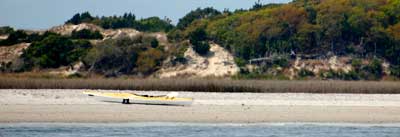Hammocks Beach State Park & Bear Island
Venture to Bear Island and reward yourself with vivid memories of one of the most unspoiled beaches on the Atlantic coast. Accessible only by passenger ferry or private boat, there's just one thing at Hammocks Beach that's crowded?the list of things to do.
 Stroll the beach with laughing gulls and sandpipers. Cast a baited hook into endless rows of foaming breakers. Discover tiny specimens of marine life in tidal pools and mudflats. Use a camera or paintbrush to capture the green and gold grasses that color the salt marshes. Spend the night among the sand dunes, or simply bask in the sun and do nothing at all. Secluded and tranquil, free from intruding commercialism, Hammocks Beach may not be for everyone, but the island is a retreat for people who welcome the challenges of relentless sun, sand, sea and sky. Except for 33 acres on the mainland, Hammocks Beach State Park is located on Bear Island and Huggins Island. Bear Island is an 892-acre barrier island. The island, 3.5 miles long and less than a mile wide, is bordered by the Atlantic Ocean to the south and by salt marshes, estuarine creeks and the Intracoastal Waterway to the north. Bogue Inlet lies at the northeast end of the island; Bear Inlet lies to the southwest. Shrub thickets and maritime forests create a wilderness environment, yet in parts of the island it's easy to imagine you're in the desert. Seawater has not washed over the island in recent years. Thus, large dunes and sand ridges dominate the landscape. Migrating sand, carried by the wind, often buries portions of the maritime forest. |
Perhaps the most interesting animal found on the island is the loggerhead sea turtle. Between mid-May and late August, female loggerheads come ashore at night to nest above the high-tide line. Weighing from 150 to 300 pounds, the females nest every three or four years, laying up to six nests a year. Nests range from 10 to 20 inches deep and often contain 120 eggs. The eggs are about the size of ping-pong balls. After a two-month incubation, the hatchlings emerge from the nest and race to the sea.
The life of the loggerhead sea turtle is not an easy one. Danger is always around the corner. Raccoons and foxes often forage the nests, and ghost crabs and other nocturnal animals often feed on the hatchlings. Young turtles are often preyed upon in the ocean and adult turtles have been adversely affected by human populations. Should the loggerhead manage to survive these threats, it may live up to 70 or 80 years and may weigh as much as 400 pounds. The loggerhead turtle is on the federal list of endangered and threatened species. Those who disturb or harm turtles, nests or hatchlings are subject to penalty. Huggins Island, located just east of Bear Island in the mouth of Bogue Inlet, is a 225-acre island visible from downtown Swansboro. The island consists of 115 acres of upland area surrounded by 96 acres of lowland marsh. The island's varied natural habitats and cultural resources contributed to the its inclusion in the state parks system. Huggins Island is home to a maritime swamp forest, which is listed as a Globally Rare and Significant Area. Huggins Island has a rich history, from Native American fishing and hunting grounds, to being home to a Confederate six-cannon battery in 1861-62. Its commanding view of Bogue Inlet and the town of Swansboro was an obvious strategic value. For visitors familiar with Hammocks Beach State Park, Huggins Island's thick, dense maritime forest is a stark contrast to Bear Island's sandy beach and open dunes bursting with sea oats.  Hammocks Beach is also a haven for migratory shore birds who feed in tidal marshes and rest on the beach in the spring and fall. Watch herons and egrets search for food or witness osprey plunging into tidal creeks to capture fish. Bottlenose dolphins swim offshore, while white-tailed deer, raccoons and gray fox inhabit inland areas. Tall dunes vegetated by sea oats, American beachgrass and seaside goldenrod lend a golden glow to open areas of the park. At the northeast end of the island is a maritime forest populated by loblolly pine, red cedar, red maple, red bay and various oaks. The northwest portion of the island is primarily marsh, dominated by cordgrass and needle rush. |
- Home
- The Park